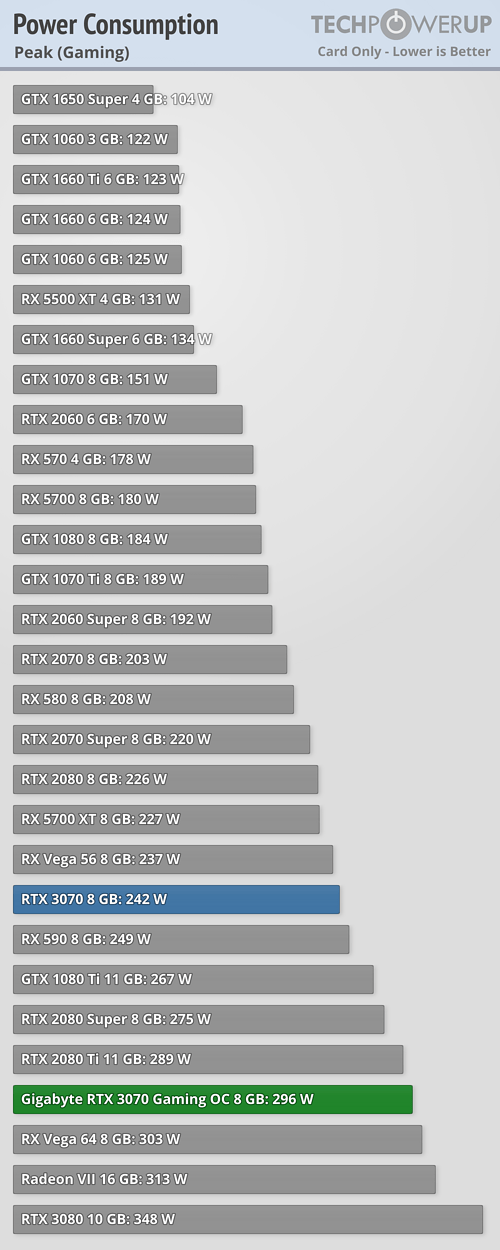 11
11
Gigabyte GeForce RTX 3070 Gaming OC Review
Clock Speeds & Power Limit »Power Consumption
Non-gaming power consumption is a few watts higher than with the RTX 3070 FE, but not by enough to worry.
In gaming, the card is quite close to the RTX 3070 FE in power consumption, around 10 W higher. The peaks and Furmark do go higher because Gigabyte increased their card's power limit to 270 W, which is a good thing as it allows Boost to clock the card higher for longer.
Minimum recommended PSU: 650 W






Apr 24th, 2025 10:34 EDT
change timezone
Latest GPU Drivers
New Forum Posts
- Are the 8 GB cards worth it? (135)
- The TPU UK Clubhouse (26167)
- To distill or not distill what say ye? (83)
- AAF Optimus Modded Driver For Windows 10 & Windows 11 - Only for Realtek HDAUDIO Chips (442)
- What are you playing? (23456)
- 5060 Ti 8GB DOA (263)
- New GPU 5070 Ti or better CPU Ryzen7 7800X3D ? (13)
- Microcenter GPU Stock status (85)
- Help in overclocking the AMD Ryzen 7 7700 in ASUS TUF B650-PLUS WiFi Mobo (1)
- TPU's Nostalgic Hardware Club (20274)
Popular Reviews
- NVIDIA GeForce RTX 5060 Ti 8 GB Review - So Many Compromises
- Colorful iGame B860M Ultra V20 Review
- ASUS GeForce RTX 5060 Ti TUF OC 16 GB Review
- ASRock X870E Taichi Lite Review
- Upcoming Hardware Launches 2025 (Updated Apr 2025)
- Sapphire Radeon RX 9070 XT Pulse Review
- Sapphire Radeon RX 9070 XT Nitro+ Review - Beating NVIDIA
- NVIDIA GeForce RTX 5060 Ti PCI-Express x8 Scaling
- AMD Ryzen 7 9800X3D Review - The Best Gaming Processor
- ASUS GeForce RTX 5080 TUF OC Review
Controversial News Posts
- NVIDIA GeForce RTX 5060 Ti 16 GB SKU Likely Launching at $499, According to Supply Chain Leak (182)
- NVIDIA Sends MSRP Numbers to Partners: GeForce RTX 5060 Ti 8 GB at $379, RTX 5060 Ti 16 GB at $429 (127)
- NVIDIA Launches GeForce RTX 5060 Series, Beginning with RTX 5060 Ti This Week (115)
- Nintendo Confirms That Switch 2 Joy-Cons Will Not Utilize Hall Effect Stick Technology (105)
- Nintendo Switch 2 Launches June 5 at $449.99 with New Hardware and Games (99)
- Sony Increases the PS5 Pricing in EMEA and ANZ by Around 25 Percent (85)
- NVIDIA PhysX and Flow Made Fully Open-Source (77)
- Windows Notepad Gets Microsoft Copilot Integration (75)